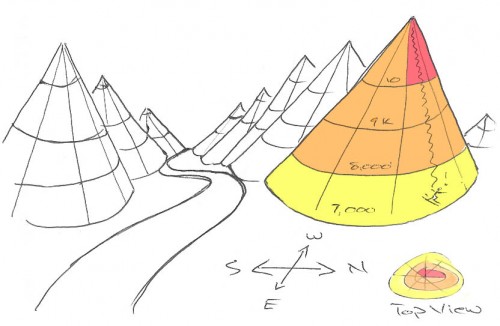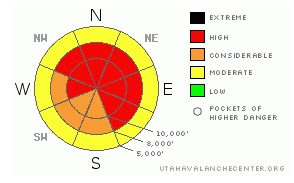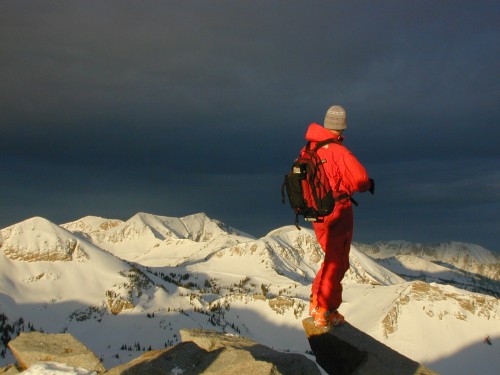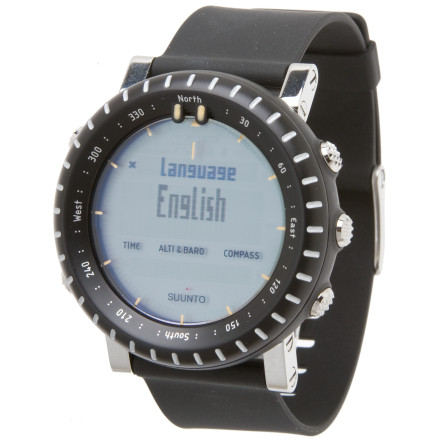Deciphering the Avalanche Rose
The idea of an “avalanche rose” has been around for a while, but has been making its way into avalanche forecasts where it is one of my favorite quick-hit summaries of the current avalanche stability. The “rose” part come from the concept of a compass rose (north, south, east & west pointers with sub quads) and the avalanche part comes from, well, avalanches. I like the avalanche rose as it is a very quick, graphical overview. I wouldn’t ski a slope based only on the info gleaned from an avalanche rose diagram, but it would give me a big head-start on where to start looking for trouble or safe skiing for the day.

- … the same view through the eyes of the avalanche rose. In the above illustration, the skier probably would have triggered an avalanche up in the red zone.
The avalanche rose is a stylized top view of a mountain which splits the world into aspects and elevations, then assigns an avalanche danger accordingly. It is a rough estimate and not like you can suddenly cross the 10,000′ foot line, or from NW to North and have the danger dissipate, but it gives a good general idea. Much like a traffic light, red means “stop – high danger” (beyond that is extreme/black, which is rare), and green is “go – low danger,” which makes it easy to figure out.
The avalanche rose in action on a daily UAC forecast:

________________________________
Help support StraightChuter.com and know your exact elevation with a Suunto Core Altimeter Watch from Backcountry.com! Click on the photo below…
Category: 07 Avalanche Avoidance











ATA,
You’ve an advertisement for the Suunto Core below today’s post. Which Suunto do you like for BC skiing?
-Shelby
Hi Shelby – I have a Suunto X6 HR Ti which, as much as anything, I like because I know how to use it and I’ve had it for a couple of years. Any of the X6 models work well for skiing (I don’t use the HR/heart rate function).
The new Core series is a generally more affordable, easier to read version of the classic Suunto. I haven’t used a Core watch, but a lot of skiers seem to like them.
The prices on Suunto watches varies quite a bit according to the finish (stainless, Titanium, etc, vs. regular) but the guts are the same for similar models.
Thanks! I was looking at the Observer or X6 series…Core is too much like a saucer dish for my girly arms. How well does the clinometer work on the X6? Appreciate the advice.
Like many modern day products, the owner’s manuals on Suunto watches dwarf the actual product, and I have to admit to knowing only about 1/2 of the overall functions of my X6 (I think Greg Hill knows them all). I’ve used the clinometer function on an earlier Suunto watch and thought that it worked well, but perhaps not as accurately as a real clinometer, which has a longer sighting surface, or in some cases, actual sights.
Still, as a one tool to do it all, the Suunto packs a lot of useful features in. Just for girly arm reference, my wife, Polly, uses an X6 as well and likes/loves it.
Thanks!! Happy Holiday!
“Avalanche rose”… seems like a great way to summarize in a bit more detail (aspect, elev) the avy hazard conditions in forecasting. In the PNW, the Northwest Avalanche Center (NWAC) puts out pretty detailed reports but they do not utilize this “avy rose” diagram, I wonder why not… is there some inherent difficulties in avy forcasting by apsect & elev depending on geographical location, i would think (hope) not?
Hi Cesare – I’m not sure why the avalanche rose isn’t used more, but it could be because of technical issues. When I was forecasting in 2003, there wasn’t a fast, easy way of generating them, so we didn’t use them. Doing them one at a time isn’t too bad, but to fire them off quickly in the morning along with all the other work that goes into a forecast means the forecasters must have some little program to help them out (I would hope..!).
The avalanche rose:
CesarO wondered why every avalanche center does not use them. Part of the reason is technical. In the past, we used a java script originally written for the Colorado Avalanche information Center (my good friend Ethan stole the idea from us). But it was clunky. Nowadays we use a website built by DharmaTech and they built a nifty danger rose generator right into the site and we can update it very quickly in the morning. Since it’s open source and free, other avalanche center will likely get onboard.
The second reason other avalanche centers may not use the rose is that they simply don’t have enough information. Here in the Wasatch, we have 12 ski areas and a million and a half people at the base of the range that track up every square centimeter on a daily basis. So we have a huge amount of information and we can make the roses quite accurate. Contrast our situation to, say, Canada, where they forecast for areas as large as Utah with very few people sending observations. They just don’t have enough information to put out an accurate rose, so they stick with a general danger rating. The Pacific Northwest has mostly cloudy days, and are far north, so there is not much difference by aspect. They could easily use the rose for elevation, which is critical in maritime climates. I believe they want to start using the rose, but I’m not sure of their time schedule.
Thanks for the good info Bruce… would be great (ie helpful) to see the NWAC start using the “rose” as part of their daily forecasting.